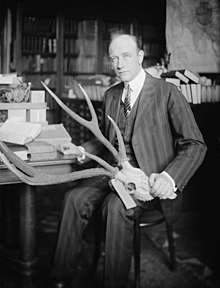Roy Chapman Andrews | |
|---|---|
 | |
| Born | January 26, 1884 Beloit, Wisconsin, U.S. |
| Died | March 11, 1960 (aged 76) |
| Resting place | Oakwood Cemetery, Beloit, Wisconsin, U.S. |
| Nationality | American |
| Education | Beloit College Columbia University |
| Occupation(s) | Explorer, adventurer, naturalist |
| Years active | 1909–1960 |
| Employer | American Museum of Natural History |
| Known for | Paleontological field work |
| Spouses |
|
| Awards | Hubbard Medal (1931) Charles P. Daly Medal (1935) Vega Medal (1937) Cover of Time Magazine, October 29, 1923 |
Roy Chapman Andrews (January 26, 1884 – March 11, 1960) was an American explorer, adventurer, and naturalist who became the director of the American Museum of Natural History.[1] He led a series of expeditions through the politically disturbed China of the early 20th century into the Gobi Desert and Mongolia. The expeditions made important discoveries and brought the first-known fossil dinosaur eggs to the museum. Chapman's popular writing about his adventures made him famous.